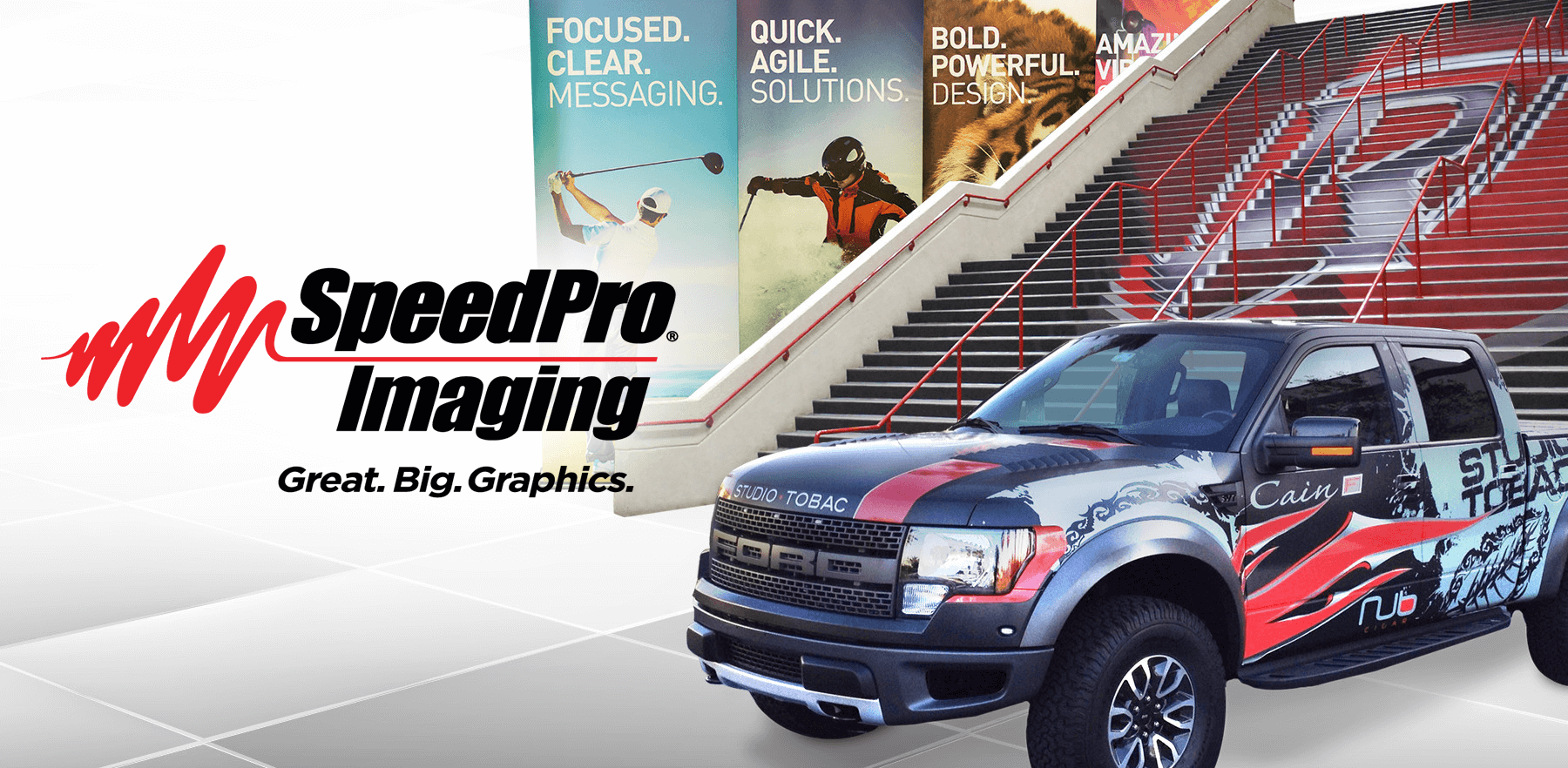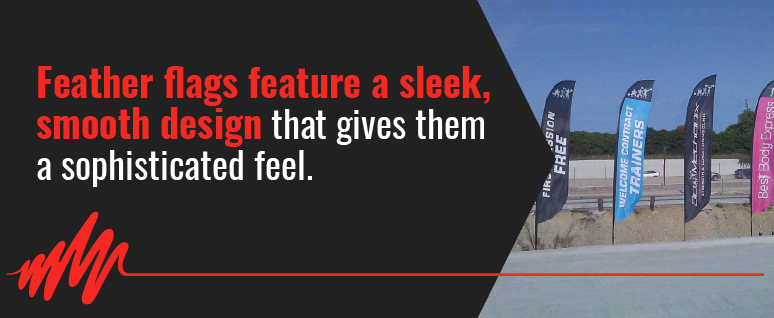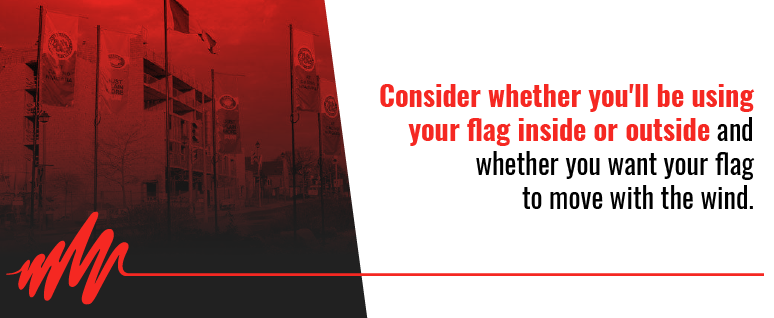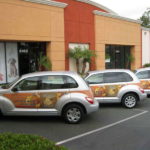
Get Noticed With Advertising Flags
AUGUST 13, 2019| SpeedPro Mile HighCategories
UncategorizedFlags are an excellent way to promote your business — both indoors and out. Advertising flags are easy to set up and ideal for getting people’s attention and getting your message across to them. You can use business flags For several things. You can place them outside your business, set them up inside your office, make them a part of your trade show display or use them at your next outdoor event. If you use them outside, they’ll flutter in the wind, helping to draw people’s attention to your message.
When you work with SpeedPro on a custom marketing flag, you can be sure you’re getting a high-quality product that will represent your brand well.
Flags are a great option for a variety of uses, but how do you know which kind is right for you? There are various types and several options for customizing your display. What are the different styles of advertising flags? Let’s take a look.
FLAG SHAPE
The most obvious difference between various flags is their shape. There are several different shapes of advertising flags, including feather, straight, teardrop and edge.
1. STRAIGHT FLAGS
Straight flags have a classic shape that features a straight vertical edge along the side furthest from the pole and a straight edge along the bottom. The side attached to the pole is mostly straight but curves at the top, along with the pole, until it meets the other edge of the flag. The straight flag style has a simpler design that will give you a substantial amount of room
2. EDGE FLAGS
The edge flag is the simplest of our four flag designs, and it also gives the most room on which to display a message. Edge flags are rectangular and have longer vertical edges and shorter horizontal edges. The style is similar to that of a standing banner display. The flag pole runs along one side of the flag, and there’s a bar across the top to keep the flag in place. If you want a simple design with lots of room for your graphics, consider an edge flag.
See some edge flags in action here:
3. FEATHER FLAGS

Feather flags feature a sleek, smooth design that gives them a sophisticated feel. The shape of the flag is, as the name suggests, similar to that of a feather. Like the straight flag, it is mostly straight along the side where the pole is and then curves over at the top. The flag is also curved to a similar degree along the bottom, although there’s no pole there. This flag offers a unique style that will catch people’s attention as they walk by.
4. TEARDROP FLAGS
Teardrop flags are another eye-catching, curved flag style. They are, of course, shaped like a teardrop and feature a pole that bends over the top to create a rounded shape. The side of the flag furthest from the pole comes down at an angle, and the side attached to the pole is more curved than in the other designs. Due to its shape, this type is ideal for when you don’t want your flag to move with the wind.
WHICH FLAG SHAPE SHOULD YOU CHOOSE?
What type of advertising flag is best for you? Consider the following factors:
- How much space you need: When you opt for a unique style, you typically give up some of the space you could use to print your graphic. A simpler design, on the other hand, has fewer curves, giving you more space for your design. You’ll have to choose whether you want to prioritize style or messaging space. Both qualities have their advantages, so the choice is up to your preferences. If you want a simpler design with more space, choose a straight or edge option. If you want a more eye-catching shape, choose a feather or teardrop flag.
- Your brand: One factor that can help you choose whether to prioritize style or graphic space is your brand. If your brand is more straightforward, you may want to select a simpler design. If it’s a little more fun, you may want to choose a more eye-catching design. Look at each flag, consider what qualities the shape makes you think of and then think about whether those qualities fit your brand. For example, the feather shape tends to look more sleek and sophisticated, while the straight flag shape is more to the point.
- The event you’re using it for: You may also want to think about the event you’re using the flag for. A business event may require a simple, business-like design, while a concert or sporting event may call for a fun, creative style. If other flags at the event are a certain shape, you may want to match them or, alternatively, choose a different shape so that your flag stands out.
- Whether you’ll be using it indoors or outside: Also, consider whether you’ll be using your flag inside or outside and whether you want your flag to move with the wind. Teardrop flags tend to flutter less in the wind since they’re closely attached to the pole. Feather flags flutter less than edge and straight flags but more than teardrop ones.

SINGLE-SIDED AND DOUBLE-SIDED FLAGS
You also have another option when it comes to your flag’s design — whether to use a single-sided or a double-sided graphic. If you choose a single-sided flag, your graphic will be printed on just one side of the flag. The material of the flag, however, will be somewhat see-through, so you’ll also see the graphic from the other side, although the images and text will be backwards. If you choose a double-sided flag, you’ll get two panels of material printed with your graphic, one on each side.
If people will mostly be looking at your flag from one side, a one-sided flag will work for you. If people will see it from both sides and you want it to be noticed no matter the angle, go with a double-sided flag.
FLAG HEIGHT
You can also get promotional flags in a variety of sizes, ranging from around 7 feet tall to more than 15 feet. The flags themselves vary in size, and some flag poles are adjustable, so you can change the height of your flags according to your needs.
Here are some examples of the sizes of some of our flags. The exact dimensions will vary a bit depending on the shape — straight, edge, feather or teardrop — you choose.
- Zoom Flex Small Flag: 46″ – 64″W x 84.13″ – 113.13″H x 1.75″D
- Zoom Flex Medium Flag: 46″ – 64″W x 116.13″ – 138.63″H x 1.75″D
- Zoom Flex Large Flag: 46″ – 64″W x 160.13″ – 178.38″H x 1.75″D
- Zoom Flex Extra Large Flag: 34.63″W x 222.5″H x 1.75″D
- Wind Dancer Mini Flag: 16.31″W x 56″ – 100.32″H x 16.31″D
- Wind Dancer LT Flag: 36″W x 116″ – 162″H x 25.5″D
- Wind Dancer Flag: 36″W x 209″H x 36″D
One factor to consider when you’re choosing the size of your flag is how much space you have available. At a trade show, for example, you’re likely to have much less room than you do at an outdoor event. If you’re placing your flag in the front lobby of your office or in a trade show booth, people will be very close to it, so you may want to choose a smaller flag so that the focal point of your graphic is close to eye level. If people will be seeing your flag as they drive by or from a distance, go with a larger size.
TYPES OF BASES
Setting up a promotional flag is a simple process. To assemble your display, just put the pole together, slide the flag onto the pole and then attach the pole to a base. You can use various kinds of tools to secure your flag, including:
- Ground stakes: You can attach ground stakes to your flag pole and then stick the stake right into the ground. Flags often come with ground stakes.
- Auger stakes: Auger stakes have a spiral bit design that bores into the ground. Attach your flag pole to the top of the stake.
- Cross bases: Cross bases features two poles arranged in an X shape to give your flag added stability.
- Steel square bases: Steel square bases are solid square-shaped pieces of steel onto which you can stick your flag pole.
- Fillable bases: You can fill this tire-shaped base with up to seven gallons of liquid to add weight to your base and hold your flag in place.
- Water ring fillable bases: Fill a water ring with up to a gallon of water and then place it on one of the other bases to add extra weight.
- Drive-over bases: Drive-over bases feature a spot for your flag pole and two metal arms that come out one side of the base. Drive a vehicle so that one of its tires is on top of the metal arms to hold the flag in place.
The right base for you depends on where you’re setting your flag up and what resources are available to you. If you can place your flag directly into the ground, a ground stake or auger stake will work for you. The other options will work best if you can’t.
WHY USE PROMOTIONAL FLAGS?
Advertising flags are excellent promotional tools for a variety of situations, including outdoors at events, inside at trade shows or in your office. You could, for example, line the sidewalk leading up to your business with flags to catch people’s attention to a sale that you’re having. You could also place flags outside at an event highlighting your company and services.
Flags are useful in all of these scenarios because of the advantages they provide. Here are some reasons to use marketing flags:
- They’re versatile: Advertising flags are really versatile. They’re durable enough to use outside, but you can use them indoors as well. They’re also easy to set up and take down, so you can quickly move them around whenever you need to.
- They’re eye-catching: Flags are great at getting people’s attention. They stand out more than certain other common types of advertisements, such as billboards. Additionally, when you use them for outdoor advertising, they may move in the wind.
- They can help build brand awareness: Flags are excellent tools for building brand awareness. Even something as simple as placing your logo on a flag can help people get to know your brand better. You can also put things such as your company logo, images, catchphrase and more on flags.
- They’re customizable: As you can see from all of the options discussed in this article, there are many different types of advertising flags. You can choose various shapes, heights, graphic styles and bases for your flags and, with some flag poles, even adjust their height as needed.
.









